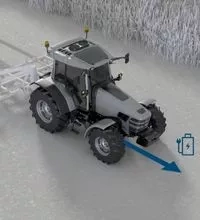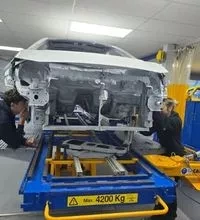Truckin’ on gas
In this article: We need to reduce tailpipe emissions and improve air quality. Hydrogen is the best solution – well, for commercial vehicles at least…
When it comes to emissions, hydrogen is, in some quarters, viewed as the silver bullet. It offers similar refuelling times and performance levels to those of the combustion engines most vehicles use today but without the tailpipe emissions that poison the air we breathe. In fact, the only output from a hydrogen engine is water.
There’s a problem, though. Hydrogen technology is seemingly forever ten years away from mass-market introduction. But that’s in passenger vehicles, where the costs are prohibitive – commercial vehicles, whether trucks or buses, offer an easier route into the mainstream for hydrogen technology.
Gas we don’t mind
Hydrogen is a route being pursued by US manufacturer Nikola, which has come up with the Tre tractor unit. The Tre is produced as either a 6x2 or a 6x4 and is designed to haul a semi-trailer. It’s fitted with a 120kW hydrogen fuel cell, plus a 800V DC battery pack. Power output ranges from 500hp to a mighty 1,000hp – considerably more than is offered by the diesel-powered tractor units currently on sale – and the Tre has a claimed range of up to 750 miles, depending on the exact specifications. Payload capacity will be on a par with that of equivalent diesel models, promises Nikola.
Scheduled to go into production in 2022-23, the Tre looks set to be built in Europe. ‘Tre’ means ‘three’ in Norwegian, and Norway is where the truck will start its European trials, scheduled for next year.
Tre bon for the environment
The choice of Norway as a test bed is undoubtedly deliberate. It has an abundance of environmentally friendly hydroelectricity – and a lot of electricity is needed to produce hydrogen.
The equation works from a financial viewpoint if the electricity is cheap, and from an environmental viewpoint if it comes from a sustainable source. But, if it is generated by coal- or gas-fired power stations, then the environmental argument becomes a lot less convincing.
Giant US brewing group Anheuser-Busch is convinced, it has placed an order for up to 800 US-specification Nikola fuel cell trucks for use in its long-haul distribution operation in North America. Designed with a range of 500 to 1,200 miles, they can be refuelled in less than 20 minutes, says Nikola, and will start arriving in the Anheuser-Busch fleet in 2020.
But Nikola isn’t the only company developing the technology. Hyundai is developing a rigid truck with a 190kW fuel cell system and a rather more modest range of 250 miles. It aims to supply 1,000 to the Swiss market between now and 2023.
Hydrogens and lows
Even if the electricity used to produce hydrogen is inexpensive and has unimpeachable green credentials, hydrogen as a fuel has some key drawbacks, points out Martin Flach, former Alternative Fuels Director at Iveco’s UK operation and now one of the truck industry’s leading independent alternative fuel consultants.
“Hydrogen requires big onboard tanks because its energy density is low,” he points out. Those tanks take up a lot of space and make packaging the vehicle a challenge. Hyundai’s rigid truck will have eight big hydrogen tanks slotted into various areas, such as between the back of the cab and the front of the body.
Packaging is one issue – refuelling is another. Nikola is working with Norway’s Nel Hydrogen to develop a network of over 700 refuelling points across the US and Canada, which, it says, should be in place by 2028. Its first European hydrogen station should open in 2022, and it aims to have a network in place that should cover most of Europe by 2030.
Although the price is falling, hydrogen fuel cell vehicles also remain expensive. A 12m-long single-decker bus with a fuel cell is likely to carry a price tag of almost £560,000 – around £200,00 more than an equivalent pure-electric bus
What all this means for you
It’s clear that hydrogen is one of the most important alternative fuels currently in development. For cost and infrastructure reasons, it actually may not turn out to be the silver bullet that many hope for, but it will certainly play an increasingly important role in transportation.




